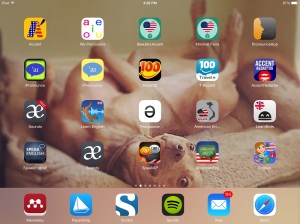A few weeks ago I set out to write a blog post about each of the more than 100 iOS apps that I downloaded from the iTunes store to my iPad that focus on English pronunciation (see that posting). I have now written ten postings on ten different apps and I wanted to summarize some of my initial findings.
One would think that iPads and iPhones would allow for greater use of technology, but sometimes that technology gets in the way. For both newer and older apps, I found multiple instances of them crashing or freezing (Accent Redactor never would load for me). It is encouraging when a newer app makes updates to fix technical issues (such as Beautiful Accent 1), but many apps have missing functionality that the developers seem to have ignored (such as AccentZ with the “artificial intelligence” not working and iPronounce! with the keyboard not functioning). It is possible that because Apple puts out numerous updates to their operating system that these apps lose some of their functionality when the developers do not keep up with their updates. This could be an issue overall–developers may release their app (perhaps with an update or two) and then abandon them without removing them from the iTunes store.
After each of my postings to this blog, I did copy and paste my “DJ’s Perspective” section and submit it as a review in the iTunes store with mention of this blog to see the full posting. One app developer (APP of Beautiful Accent 1 & 2) did take the opportunity to read my full posting on Beautiful Accent Minimal Pairs and write to me. They thanked me for my feedback and justified some of their reasons (to which I responded with additional information). It is encouraging to see at least one app developer take the time to read my posting, respond, and communicate a desire to make improvements. It may be that this developer responded because they are working so hard to market themselves on Twitter (@Beautifu1Accent). I am still early in this process and will see if other developers contact me.
Of the ten apps I have gone through, I do not see evidence of the developers having a firm background in Applied Linguistics, Second Language Acquisition, or Teaching English Pronunciation. These apps seem to take easy-to-package content and try to make it look appealing on the screen and market it to whoever will purchase their app (of these ten apps, eight are paid apps or have an in-app purchase). While the ticket price may seem inexpensive, buying multiple apps can quickly add up (I have already spent more than $175 on apps for this project).
When considering purchasing an app, one should keep in mind that while Apple reviews all apps before they are released, they are reviewed for technical issues, rather than content. Textbooks published by academic presses go through a far more thorough review process that often includes sending copies of the material to a content specialist. Most apps do not go through this kind of process.
Another thing to consider is that when you buy a textbook, a CD, or a folder of mp3s that these materials do not rely on a device that frequently updates to a new operating system and even changes dimensions (consider how often the iPhone has changed its screen size).
In terms of content, most of these apps are limited in scope. Consonant and vowel sounds are popular topics followed by the repetition of words and short phrases. The app American Accent is the closest I have seen so far to address multiple features of pronunciation, yet this app still falls short. I will be interested to see how other apps measure up and I will keep you informed.
DJ Kaiser, PhD
djkaiser@webster.edu
All material Copyright © DJ Kaiser, 2015

